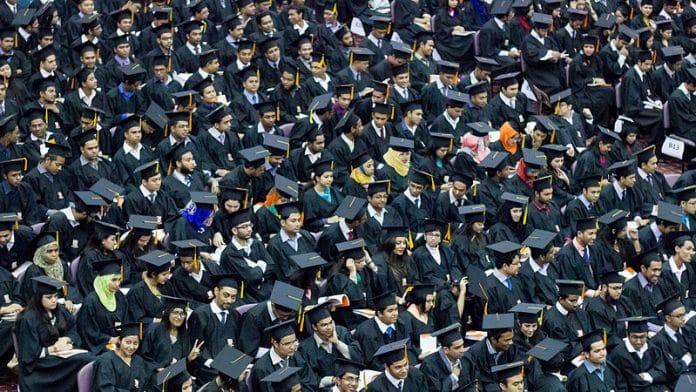Thank you dear subscribers, we are overwhelmed with your response.
Your Turn is a unique section from ThePrint featuring points of view from its subscribers. If you are a subscriber, have a point of view, please send it to us. If not, do subscribe here: https://theprint.in/subscribe/
This article does not concern itself with the employment prospects of those who pursue postgraduate professional degrees, secure government jobs, enter academia or inherit family businesses. Instead, the focus here is on the employability challenges that regular arts graduates face. According to Statista, the employability among graduates with a BA across India is only 47.1% in 2024, a decrease from about 49% in 2023.
In fact, a majority of students who enrol for higher education choose arts, science and commerce instead of professional courses like engineering, medicine or law. Of these, 33.5% of students choose arts programmes, driven perhaps by genuine interest, inability to secure admission to professional programmes or financial constraints. The systemic imbalance between the demand and supply of educational opportunities is a matter of policy and economic factors.
The View from Liberal Arts
In principle, social sciences and humanities resist the instrumental view of learning. These disciplines aim to develop citizens who can question societal norms, challenge existing narratives and focus on questions of justice. They also temper the unbridled optimism of science, technology and markets with considerations of fairness. The pursuit of knowledge in liberal arts is not merely an end in itself; it’s a catalyst for progressive ideas that take a society forward.
The reality falls short of the ideals though. While liberal arts education aspires to uplift the marginalized, the outcomes only reinforce existing caste-class hierarchies. For instance, a sociology graduate from an upper-middle-class family in a metro city is much more likely to secure a well-paying job than a low-income student from a small-town college who holds the same qualification. The former may have access to networks, internships, and mentors that the latter cannot even dream of.
A Question of Quality
The majority of arts students in India study in non-elite colleges, with traditional pedagogy and limited exposure to internships and field projects. How do these students develop the power to think critically, analyse arguments and nurture a disposition for complex problem-solving? These skills can indeed be developed when colleges encourage active discussions, research orientation and projects that help sharpen real-world competencies.
India’s education system remains deeply divided, with a stark contrast between elite colleges/universities and struggling local institutions. Students need 90% or higher in their 12th to secure admission in top-end public colleges in tier 1 cities while elite private universities charge exorbitant fees. This is exactly the kind of divide highlighted in social sciences texts. Are we to accept this educational model that cements these social silos as the norm?
It’s no surprise you often hear the argument that liberal arts are the exclusive privilege of the leisurely class, and for the middle class and poor, a sure path to unemployment. The notion that liberal arts are meant only for dinner table conversations of the wealthy not only delegitimises their significance but also attempts to strip away the transformative potential of liberal education from those who need it most. As is evident in the case of wealthy liberal arts students from top-end colleges landing well-paying jobs, it’s clear the issue is not inherent to the discipline itself. It boils down to three factors: one, social capital; two, institutional reputation; and three, the state of our economy and job creation.
Academic Ideals and Market realities
Irrespective of where you graduate from, the ideals of liberal arts often clash with neo-liberal realities. Employers prioritise ‘practical’ skills over the nuanced perspectives of a well-read liberal arts graduate. For instance, a telecom company hiring literature graduates for customer service roles may value their communication skills over critical reading/witing skills. An automotive firm recruiting cultural studies graduates for their public relations positions might value their relationship-building skills over media literacy. It’s just that graduates with the “required” social capital can negotiate these realities much bette than those who lack it.
The challenge, then, is not to bridge the gap between the aims of liberal education and market needs. It’s about ensuring that all students are equipped to navigate these realities, even while fighting it. It’s about reinforcing that practical orientation is not about disregarding inequities; it’s about learning to survive first in order to fight the good fight.
In fact, we must challenge the narrow definition of “employability” itself. It’s high time employers recognized the long-term value that liberal arts graduates, particularly from smaller towns, could bring to the workforce. These students often think differently, reason sharply and possess keen social insights. Most important: jobs that require exploratory thinking, discernment and a deep understanding of human behaviour – skills cultivated in liberal arts – are less likely to be automated by AI.
[The author is a Professor of Practice at Tata Institute of Social Sciences. Views are personal.]
These pieces are being published as they have been received – they have not been edited/fact-checked by ThePrint


